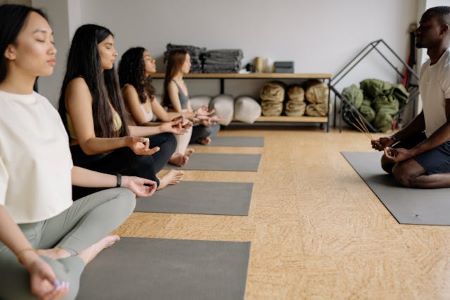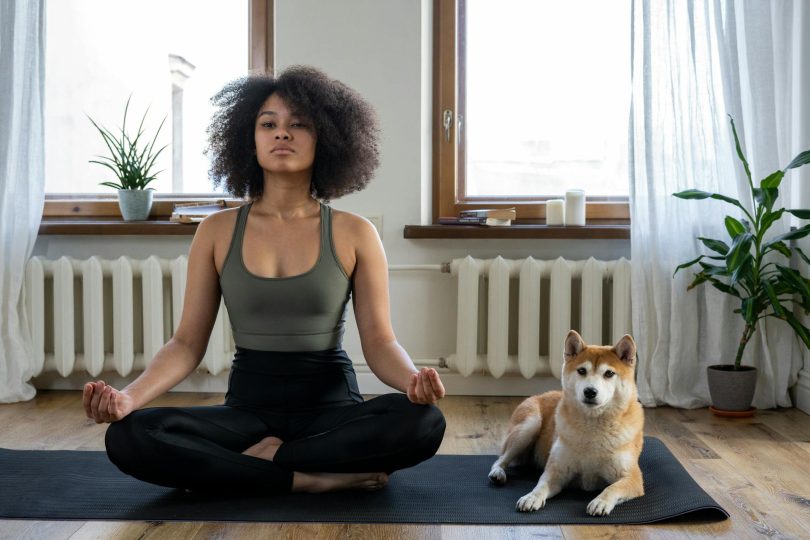Revealing the Power of Aum & Beyond
Hands up, who’s been in a yoga practice and chanted ‘Aum’ at the end without any explanation or information as to how or why it was included?

I know I have, many times, and honestly, I just thought it was something we did in yoga. I kind of knew it was spiritual, but that really was the extent of my knowledge. Although I was intrigued by yoga, I never really did any more research into it because, you know, life.
It wasn’t until I did my own Yoga Teacher Training in 2020 that I was taught the importance of chanting and that there was so much more beyond Aum. This also inspired me to deepen my understanding by doing my own research into the meaning behind the symbol, the sound, how we verbalise it, and why we even chant it in the first place.
That being said, it took me three years before I shared chanting in my own practices.
Why?
Confidence, or lack thereof. Wanting to do it right, to make sure it’s perfect, and that I’d be able to answer any questions about it easily. Basically, if I didn’t know it inside out, then I didn’t feel comfortable sharing it, and I think this is part of the problem with a lot of teachers who put unnecessary pressure on themselves like I did.

Even though I felt confident sharing the knowledge I’d gained, I still wasn’t comfortable “singing” in front of other people. I know it isn’t really singing, but in my own head, that’s exactly what it was, and I was not comfortable with that for a long time. But when we put ourselves out there, we expand our comfort zones and create space for the people around us to do the same.
So, really, what was the worst thing that was going to happen?
Someone might not like it?
I guess that means I’m not the yoga teacher for them, and I’d started to be okay with that because while there absolutely is a yoga teacher for everyone, we cannot be the yoga teacher for everyone and nor should we try to be.

I believe a lot of teachers are afraid of not doing it right and perhaps being called out for appropriation when simply trying and doing so from a place of appreciation with a willingness to learn more, especially if one of our own students offers up their own knowledge, is better than not trying at all. I also believe a lot of white yoga teachers, in particular, really have to move out of their own way and take the necessary steps to overcome their own fragility so that they can hold spaces for people who truly want to deepen their personal practice and are looking for more than the physical element of yoga.
We already know the Āsana is such a small part of the entire philosophy, so why does it get almost all of the attention?
The idea, according to Susanna Barkataki (author of ‘Embrace Yoga’s Roots’), is that the energies of Aum travel from the base of the spine to the navel (creation), from the navel to the throat (sustaining), and from the throat to the crown (transform).
One of my favourite explanations of Aum is part of a TED Talk by Kurshed Batliwala, who shares that each syllable has a specific meaning and is connected to a different energy. For example, the “Ahhh” is a frequency that resonates lower down in the torso, is associated with Brahma, and therefore is a creative energy. The “Oooohhh” resonates higher up in the torso around the chest area and is associated with Vishnu, a preserving energy. The “Mmmmmmm” resonates around the head and is associated with Śiva, a transforming energy. If you think about it, these all make sense because our abdomen is literally where some of us will create new life, our lungs are our own life preservers, and the ideas we think about we can transform into reality. So perhaps by chanting, we have the potential to bring about a balance between these three energies residing within us.

Chanting has become one of my favourite things to share in my practice, and Aum is the perfect starting point because it’s so simple and easy to follow, and it opens the door to so many more chants that have their own meanings and impacts. I’ve noticed that when I share chanting during the practices I lead, my students really enjoy it and actively look forward to it. They’re using their voice in a way they may never have done so before, and that can be really empowering and liberating.
Do we chant in every yoga practice I lead?
No, but when we do, I’ve noticed that almost everyone seems to walk out of the room a little more grounded, with a smile on their face and appears a little bit lighter on their feet. I’m fortunate so far that all my students who’ve chanted with me have appreciated the opportunity to try as well as the knowledge I’ve shared to give the whole experience more meaning and purpose.

Steps I took to introduce chanting to my students:
- Choose my starting point – in this case, I chose to start with Aum.
- Build a theme or focus around the chant – I chose to focus on the spaces between our breath and the shapes we make on the mat by bringing awareness to the pause at the end of chanting Aum and before beginning the next Aum.
- Opening the practice – Introducing the focus and explaining that when we chant at the end, people can be as vocal or as quiet as they like. They can chant outwardly or be silent or simply allow the resonance to wash over them.
- All of my practices begin with prānāyama – we brought our awareness to the pauses between the inhale and the exhale.
- Āsana – I feel like we’re always in a rush to move from one shape to the next so in this practice, we took our time, slowed things right down & again, noticed each shape before moving to the next one.
- Śavāsana – Guiding people to observe the spaces between their breath again before building awareness around the spaces between their body and the ground beneath them.
- Closing the practice – guiding everyone through the meaning of Aum as explained in Kurshed Batliwala’s TED Talk and remembering to share where they can find this video should they wish to deepen their knowledge. Chanting “Aum” together after reminding people that they have autonomy and if they choose to be vocal, have the courage to be loud enough for their neighbour to hear them because in doing so they open space for others to reciprocate.

The journey of exploring chanting, particularly the sacred sound of Aum, has been transformative both personally and within my teaching practice. Through overcoming doubts and embracing vulnerability, I’ve discovered the profound impact that chanting can have on individuals’ experiences of yoga. By sharing knowledge, fostering a supportive environment, and guiding students through the practice, I’ve witnessed the empowering effects of chanting first hand.
Main – Photo by cottonbro studio




